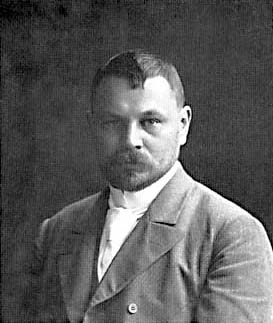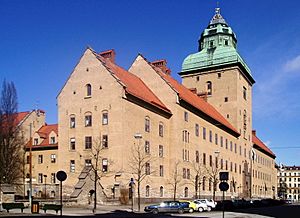Carl Westman facts for kids
Ernst Carl Westman (born February 20, 1866 – died January 23, 1936) was a famous Swedish architect and interior designer. He was one of the first to use the "National Romantic Style" in his buildings. Later in his career, he started designing in a more classic style, popular in the 1920s.
Contents
Carl Westman: A Swedish Architect
Carl Westman was an important Swedish architect who designed many famous buildings. He also created designs for furniture and other items used inside buildings.
Early Life and Training
Carl Westman was born in Uppsala, Sweden, in 1866. He studied architecture at the Royal Institute of Technology and then at the Royal Swedish Academy of Arts in Stockholm. In 1893, he married artist Elin Andersson. They moved to the United States for a short time, where he worked with another architect in New York City.
In 1895, Westman returned to Stockholm. He worked for architect Aron Johansson, who was designing the new Parliament building at the time. In 1897, Carl Westman opened his own architecture office. He became a member of the Royal Swedish Academy of Arts in 1912. Later, in 1916, he became the main architect for the Swedish Royal Medical Board.
Designing in the National Romantic Style
Carl Westman was a strong supporter of bringing Swedish traditions back into architecture. He was one of the first Swedish architects to develop the "Nordic National Romantic Style." This style mixed old Swedish building ideas and culture with new ideas from the English Arts and Crafts movement. The buildings often used materials like brick and wood.
One of Carl Westman's first buildings in this style was the Swedish General Medical Association building in Stockholm (built 1904-1906). Other well-known examples include the Röhss Museum in Gothenburg (1910-1914) and the Stockholm Court House (1911-1915). The Stockholm Courthouse looks a lot like the medieval Vadstena Castle. It is a striking building in downtown Stockholm.
Later Work: Hospitals and Classical Style
Later in his career, Westman focused on designing hospitals. He slowly started using the more classical style that became popular in the 1920s. Two important examples of his hospital designs are the Beckomberga Hospital (1927-1935) and the Karolinska Hospital (1935-1940). The Karolinska Hospital was finished after he passed away.
The Beckomberga Hospital was planned with very strict symmetry, meaning it was perfectly balanced on both sides. Its large buildings were grouped in a very practical way. For the Karolinska Hospital, Westman aimed for a more practical design, where the symmetrical look was less important.
Carl Westman also worked as an interior designer. He designed furniture and useful items for homes, like tiled stoves. He died in Stockholm in 1936.



